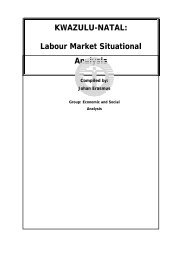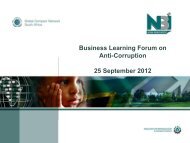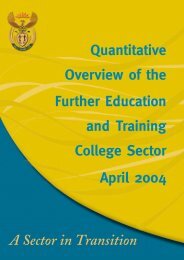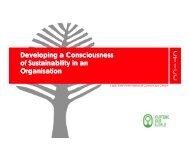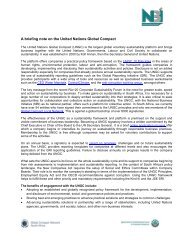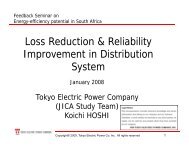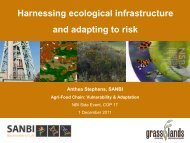Indonesia – country briefing note 1 of 1New Application HOMENature of forests and timbermovementsThe Indonesian industry is dominated by the needs of localand regional pulp and timber markets. The larger operatorswithin Indonesia tend to be those with their own facilities forpulp production and paper making, and those with largeconcession areas under management. There are also a largenumber of smaller operators, often operating informally and, itis alleged, illegally, in forest harvesting and clearanceoperations. Timber movements and exports are difficult todetermine due to the lack of transparency on product types,volumes and buyer markets within Indonesia, although it issuspected that a high proportion of timber and forest productvolumes are destined for local buyers, including China.Protected forest and enforcementEnforcement of protected areas in Indonesia is challenging fora number of reasons, including:• The huge land mass of Indonesia and the many separateislands it comprises.• Indonesia as a country has a relatively low GDP and lackof resources for both forest management and enforcementactivities.• Governance, skills, training and information-sharing arelimited within the forestry sector, compounding problems ofenforcement over such a large area.Illegal logging within IndonesiaRates of illegal logging within Indonesia rank among thehighest in the world. Within Sumatra this clearance andassociated forest fires are one of the prime causes of thehaze that is experienced in the region late in each year. It isestimated that up to 80% of all logging activity in Indonesia isillegal according to commonly accepted definitions of the term.Special places and certificationIndonesian forests, and particularly Indonesia’s primaryforests, have some of the highest conservation values of allthe world’s forests. The island of Sumatra includes the onlywild populations of Sumatran tiger, thought to numberbetween 150 and 300. The tigers’ existing habitat remainsunder severe threat, both in terms of reductions in overallarea, but also through fragmentation of existing habitats. Theviability of the Sumatran tiger sub-species and its existencein the wild remains under serious threat. As in neighbouringregions, such as Sarawak in eastern Malaysia, there aremany areas of natural forests categorised as productionforest areas, in which it is believed that endangered and rarespecies and habitats are found.The attention of the international and scientific NGOcommunities remains focused on companies operating insuch areas.There are some operations in Indonesia certified to the<strong>Forest</strong> Stewardship Council (FSC) international standard, butthese take up a very small portion of overall forested areaswithin Indonesia, and an equally small number of areascertified to the local Indonesian standard, the LEI.Certification remains a challenge for the industry as a wholeacross Indonesia.Country-specific sustainability issues• An issue of international importance is the conversion ofIndonesia’s peat forests. These forests and the soilsbeneath them are one of the largest terrestrial stores ofbio-carbon, and as such their fate has become an area ofincreasing concern to scientific and conservationorganisations, as the climate change agenda has evolvedand the link to forest management has become clear.• Conversion of peat forests takes place primarily throughillegal activities and the actions of small informal loggingoperators, but it is also a part of the business models oflarger operators, including those in the pulp and papersector.• Deforestation rates within Indonesia are some of thehighest in the world.• Corruption and bribery remain specific issues forIndonesia, as does the treatment of local indigenouscommunities, although arguably this has not had thesame attention placed on it as over the border inneighbouring Sarawak (Malaysia).• Conversion of natural forest for palm oil plantations is amajor driver of deforestation and loss of wildlife inIndonesia. According to WWF, in 2006, over half (sixmillion) of the world’s 11 million hectares under palm oilplantations were in Indonesia. This figure is expected togrow in future years. About 75% of the world’s palm oiloriginates from Malaysia and Indonesia.OpportunitiesThere may be opportunities in Indonesia for organisationslooking to capitalise on the forest carbon credit market.There is significant potential to reforest degraded areas ofland with the purposes of biodiversity gains and restorationof wildlife habitat, or for the production of marketable timbermanaged to international best practices.Page 62pwc
Malaysia – country briefing note 1 of 2New Application HOMENature of forest and timber movementsMalaysia remains a heavily forested country despite highrates of forest conversion for palm oil and other uses inrecent decades. The country’s forest areas are divided into:• Gazetted areas for production forest• Protected areas for high conservation and tourism values• Industrial tree plantations or reforestationGazetted areas for production forest tend to be areas thathave been logged previously; in some cases several times,often to the extent that they can no longer be consideredprimary forest, but rather degraded or secondary forest.Other areas gazetted for production forest do however haveconservation value in several regions, which are discussedfurther below. Protected areas include Taman Negara withinthe peninsular of Malaysia and a series of national parkswithin Sabah and Sarawak in East Malaysia, on the island ofBorneo.In terms of timber movements, Malaysia remains one of theworld’s largest exporters of tropical hardwoods, if not thelargest. Exports consist, first, of primary unprocessed timberproducts, destined for local markets and originating from EastMalaysia. These tend to be, for example, sawn timber andlogs shipped from Sabah or Sarawak to Vietnam, China orother local countries.The second export category is secondary processed timberproducts, which originate predominantly from peninsularMalaysia and are shipped and exported to US and EUmarkets. For example, the UK remains one of the largestimporters of Malaysian timber products to this day.Protected forest and enforcementThere remain significant areas of land within Malaysia thatare protected through their designation as national parks orareas of scientific interest. Among these are the TamanNegara within the peninsular of Malaysia, which is famous forits 130 million years-old rainforest, its viable population ofIndo-Malay tigers and its populations of indigenous tribes.Within Sabah and Sarawak, famous protected areas withhigh scientific values include the Danum Valley conservationarea and the Maliau Basin, which remains largelyunexplored, and is an area of primary untouched lowland rainforest.Generally speaking, these areas are well protected and thepark boundaries are well enforced. However, all these areassit alongside forest concessions where production practicesand potentially illegal logging or informal deforestation maythreaten the integrity of these protected areas.One challenge for the enforcement bodies across Sabah,Sarawak and peninsular Malaysia remains that of enforcingan effective and scientifically sound level of allowable cut(AAC). This defines a sustainable level of timber harvestingand, in many cases, is not monitored on the ground to ensurethat forest operators are taking timber only at a sustainablerate.Page 63Special places and certificationWithin Malaysia, particularly within Sabah and Sarawak,there are huge areas of forest with high conservationvalues. Many areas gazetted as production forest withinthese two states have been proven to act as habitats forendangered species such as the clouded leopard, theSumatran rhino and the Asian pygmy elephant.Conservation priorities and the attentions of NGOs andother stakeholders make sustainable management ofthese production forests and clear delineation of highconservation areas essential.The national level certification standard is the MalaysianTimber Council Certification Standard (MTCS (previouslyMTCC)) (endorsed by PEFC in May 2009). The MTCS isthe standard that all SMUs within provincial Malaysia arecertified to, and an increasing number of concessionswithin Sabah and Sarawak are hoping to obtain it in thecoming years.There are a small number of concessions and plantedforest areas certified to the FSC Standard, but these arefew and far betweenpwc



